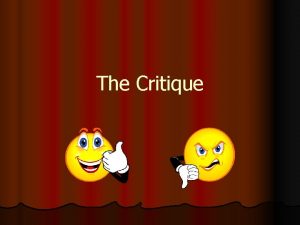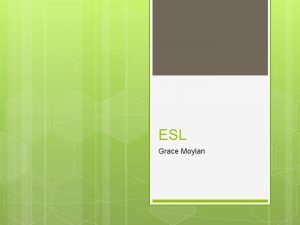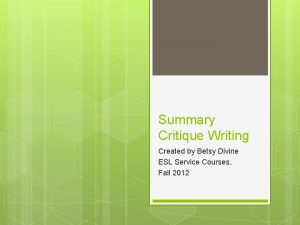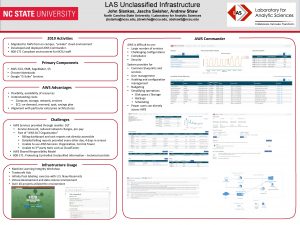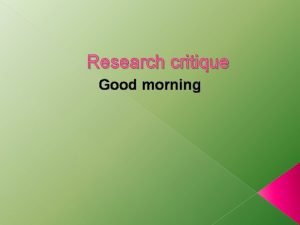Writing a Critique Nancy Swisher Lecturer in ESL









- Slides: 9

Writing a Critique Nancy Swisher Lecturer in ESL FLE 402 Fall 2016

Definition of Genre Summaries and critiques are two ways to write a review of a scientific journal article. The summary involves briefly but accurately stating the key points of the article for a reader who has not read the original article. Critique is a French word that means “a critical assessment: (positive, negative, or a mixture of both). Critiques may have various structures, but the simplest is a short summary followed by an evaluation. A critique differs from an abstract in that it includes the writer’s opinions, while the abstract does not.

Critique writing includes the higher levels of Bloom’s Taxonomy: A critical analysis of a work is an attempt to contribute positively to the greater body of research in an area. It is a kind of conversation that enhances understanding and invites discussion and further commentary.

What kinds of critiques of written texts are common in your field? What challenges are presented when evaluating the work of others? Do you agree that critiques can be challenging to write because “they require you to take on an “unfamiliar persona” that of an authority of some kind”? (Dobson and Feak, 2001)

Writing Your Critique A Dozen Questions to Consider as you Read the Article (adapted from: Swales and Feak, 2012) 1. Who is the audience? 2. What is the purpose of the article? 3. What research questions or hypotheses are being addressed in the article? Are the questions relevant? 4. Is there a literature review? If not, should there have been one?

5. What conclusions does the author draw from the research? Does the author answer yes or no to the research questions? Are the author’s conclusions valid or plausible based on the evidence? Why or why not? 6. What kind of evidence was collected to explore the research questions? Is there any evidence that could or should have been collected and included but was not? How good is the evidence? How well does the evidence support the conclusions? 7. Are the experimental methods described adequately?

8. Are the study design and methods appropriate for the purposes of the study? 9. Have the procedures been presented in enough detail to enable a reader to duplicate them? 10. Are there any important assumptions underlying the article? How do these influence the conclusions? 11. Are the charts, tables, and figures clear? Do they contribute to or detract from the article? 12. Does the research make an original contribution to the field? Why or why not?

Format A complete citation of the article goes at the top of the page. Basic Organizational Framework Brief Introduction • Describes the main argument or purpose of the work, explaining the context in which the work was created • Has a concluding sentence that foreshadows what your evaluation of the work will be: positive, negative, or mixed evaluation. Critical evaluation • Gives a systematic and detailed assessment of the different elements of the article, answering some of the questions listed above • Evaluates how well the author was able to achieve his or her goal, providing evidence from the work itself

Conclusion • States your overall evaluation of the work • Summarizes the key reasons, identified during the critical evaluation, why this evaluation was formed • Puts into perspective how the article contributes to the greater body of knowledge in the field In some circumstances, recommendations for improvement on the work may be appropriate. Reference list










